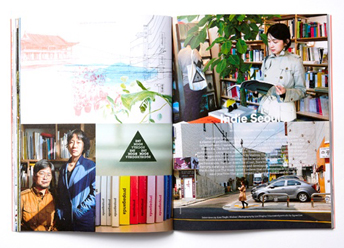 In the business of connecting travelers with affordable, memorable, and sometimes unusual rooms, Airbnb rules the roost. But for the brand that revolutionized the hospitality industry and kickstarted the sharing economy’s P2P marketplace model, storytelling is proving to be among its greatest strengths.
In the business of connecting travelers with affordable, memorable, and sometimes unusual rooms, Airbnb rules the roost. But for the brand that revolutionized the hospitality industry and kickstarted the sharing economy’s P2P marketplace model, storytelling is proving to be among its greatest strengths.
For the past 24 months, Inc. magazine’s company of the year has been crafting a lavish collection of branded content. The newest feather in its cap? Pineapple, a print magazine. The winter 2014 edition includes features like an interview with a London gallery curator and a culinary tour of Seoul. It has an initial print run of 18,000 copies earmarked for Airbnb hosts and book stores.
Airbnb calls the glossy magazine “a tangible collection of our community’s stories and inspirations.” It’s a description that speaks to the brand’s core values and identity.
What started as AirBedAndBreakfast.com in 2008, when its co-founders rented out air mattresses in the living room of their San Francisco loft, has grown into a multi-billion dollar company with more than 800,000 listings in close to 200 countries—but maintaining a brand community is still paramount. “At the end of the day, what we’re trying to do is bring the world together. You’re not getting a room, you’re getting a sense of belonging,” co-founder Brian Chesky told Inc.
In a report on the next wave of social business, corporate research firm Altimeter Group named a consumer “desire for community” as one of the driving forces behind Airbnb’s success.
Airbnb may not be supplying the end product, but it’s sure selling an experience, and when a brand facilitates a P2P service it has to gain the trust of users on all sides. In the case of Airbnb, that means cosseting both hosts and guests. Its method of choice? Rich, community-centric storytelling.
AirBnb has taken an impressively comprehensive, multi-pronged approach to storytelling. Let’s take a look all the ways they’re using content to foster a sense of belonging and stay ahead of the pack.
AIRBNB NEIGHBORHOODS
For a community-driven brand whose livelihood depends on encouraging consumers to travel, creating digital neighborhood guides is an intuitive strategy. Airbnb Neighborhoods went live in late 2012 with the promise of delivering high-quality content coupled with advice from hosts. The seven-city collection has since expanded to encompass neighborhoods in almost two dozen locales around the world.
Neighborhood content is heavily tagged with a somewhat bewildering array of area attributes (“sub culture,” “historic beginnings,” “nightlife,” “yummy mummies”) to guide users to lodging that’s right for their needs.
Maps and testimonials from travelers and residents do a lot to enhance the guides, each of which ends with a call to action inviting readers to share their local knowledge, but the cornerstone of this content is photography. In keeping with a tradition of enlisting professional photographers to elevate the appeal of its property listings, Airbnb relies on local photographers to capture a neighborhood’s vibe, and even posts their bios with each gallery. Neighborhood features are rounded out with popular area-specific listings to nudge visitors down the purchase funnel.
Read the original post at Contently.com
